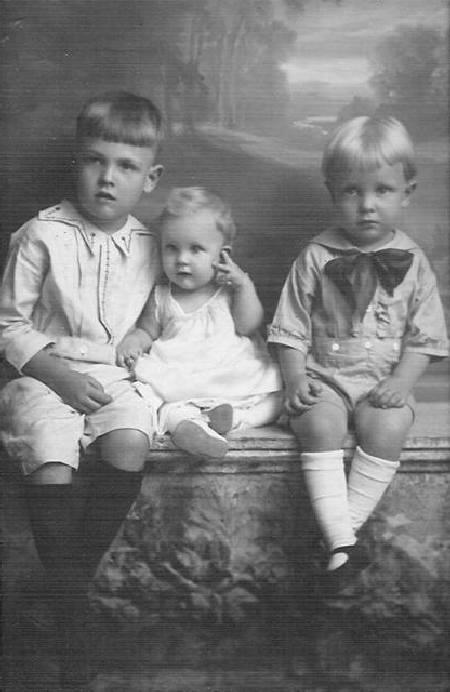
Boys' Shirts: Chronology

Figure 1.--Blouses were commonly worn by boys in the 19th and early 20th century. After Workld War I they became largely a girls garment, but younger boys continued to wear them. Here we see some American boys in the early 20th century, probably the early 20s.
|
|
Developing a chronolgy of boys' shirts is a little complicated, especially for the 19th century. This is in part because boys generally wore jackets, As a result, it is often not possible to see the shirts that they are wearing, even if images are available. Often all we can see is the collar and sometimes the sleeve cuff. We note large collars in the early 19th century. Some were worn closed and others open. The Eton collar appeared in England and eventually became a major style. Boys seem to have worn plain shirts for dress occasions during the mid-19th century. A variety of shirts were worn. Plaid seems to have been popular. Most mothers, however, insisted on adding a white collar and bow. The development of the detachable collar mean that increasing attention was paid to collars.At mid-century these collars and bows were quite small. Later in the century they got much larger. The sailor blouse alsi became widely popular. It was still not common to dress up without a suit jacket--except during the summer when fancy blouses could be worn. Much more information is available on the 20th century. There were major changes, especially after World War I. Clothing became increasingly casual. Increasingly boys wore shirts without jackets. And we see the development of not only casual collared shrts like the polo shirt, but also shirts without collars like "T"-shirts and the tank top.
Developing a chronolgy of boys' shirts is a little complicated, especially for the 19th century. This is in part because boys generally wore jackets, As a result, it is often not possible to see the shirts that they are wearing, even if images are available. We note boys wearing both blouses and shirts in the 19th century. Often all we can see is the collar and sometimes the sleeve cuff. We note large collars in the early 19th century. Some were worn closed and others open. The Eton collar, we think in the early-19th century. Bitton-on shorts seem beru cimmon at mid-century. appeared in England and eventually became a major style. Boys seem to have worn plain shirts for dress occasions during the mid-19th century. A variety of shirts were worn. Plaid seems to have been popular. Most mothers, however, insisted on adding a white collar and bow. We are not always able to destinguish between shirts and blouses. The development of the detachable collar mean that increasing attention was paid to collars. At mid-century these collars and bows were quite small. Occassionally we see slightly larger collars. An example is an unidentified American boy. We see shirts made in heavy material and worn rather like a jacket. Later in the century they got much larger. This was when fancy Fauntleroy blouses became popular. The sailor blouse also became widely popular. It was still not common to dress up without a suit jacket--except during the summer when fancy blouses could be worn. Blouses with large collars became popular in the late-19th century.
The 20th Century
Much more information is available on shirts in the 20th century. Shirts did not change substantially after the turn-of-the 20th century. We see boys commonly wearing blouses, ften with big collars and bacl flaps. Gradually we see fewer of the really large fancy collars so common in the late-19th century. Eton collars weree still worn when dressing up. There were major changes, especially after World War I. Clothing became increasingly casual. Eton collars rapidly went out of style, but were occassionally seen. Boys except for very young ones stopped wearing blouses during the 1920s. Increasingly boys wore shirts without jackets. And we see the development of not only casual collared shirts, but also shirts wuthout collars like "T"-shirts. The T-short became the quinsential boy's garment in America, but the origins were Europran. American soldiers posted to France during World War I noticed the light cotton undershirts that European soldiers wore. At the time, American soldiers wore heavy wool uniforms, even during the summer. When they returned home after the War, they wanted these shifrts which they named T-shirts because of the shape of the shirt. It took a whilr for them to become popular for boys.
French tennis luminary Rene Lacoste created the polo shirt, another step in the increasing informality of dress (1929). He was thinking primarily og a tennis garment at that was largely how it was at first worn. A variety of trendy styles appeared after World War II era. Ralph Lauren added the polo shirt it to his line and made it popular widely popular with the general public (1960s). Brroks Brothers created the button-down collar as a polo garment. It became a major shirt style when it was adopted as an element of preppy clothing (1950s). Rigby shirts became popular in the mid-1960s. Very large pointed collars appeared in the 1970s. Boys also began wearing tank tops.
HBC

Navigate the Historic Boys' Clothing Web Site:
[Return to the Main shirt page]
[Introduction]
[Activities]
[Biographies]
[Chronology]
[Clothing styles]
[Countries]
[Bibliographies]
[Contributions]
[Essays]
[FAQs]
[Glossaries]
[Images]
[Links]
[Registration]
[Tools]
[Boys' Clothing Home]
Navigate the Historic Boys' Clothing Web chronological pages:
[The 1840s]
[The 1870s]
[The 1880s]
[The 1890s]
[The 1900s]
[The 1910s]
[The 1920s]
[The 1930s]
[The 1940s]
Navigate the Historic Boys' Clothing Web sailor pages:
[Main sailor suit page]
[Reefer jackets]
[Middy blouses]
[Sailor dresses]
[Other sailor styles]
[Sailor hats]
[The Royals]
[Ring bearer/page costumes]
Created: 12:53 AM 1/27/2008
Last updated: 1:36 AM 3/16/2010



